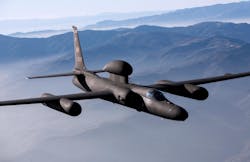Air Force asks Raytheon to build long-range ASARS-2 imaging radar for U-2 Dragon Lady reconnaissance jet
WRIGHT-PATTERSON AFB, Ohio – U.S. Air Force aerial surveillance experts are asking the Raytheon Co. to build super-high-resolution imaging radar for long-range target detection, radar mapping, and bomb damage assessment.
Officials of the Air Force Life Cycle Management Center at Wright-Patterson Air Force Base, Ohio, announced a $184 million five-year contract Friday to the Raytheon Intelligence & Space segment in El Segundo, Calif., for the Advanced Synthetic Aperture Radar System-2 -- better-known as ASARS-2.
This imaging radar is a is a multimode real-time, high-resolution reconnaissance system carried on the U-2 Dragon Lady high-altitude reconnaissance jet with all-weather, day-night, long-range mapping capabilities.
Related: The technological challenges of complex missile defense
ASARS-2 detects and locates stationary and moving ground targets with precise range in search and spotlight imagery modes. It gathers detailed information, formats the data, and transmits it via wideband data link for display of fixed or moving ground objects.
The imaging radar can produce extremely high-resolution images from long stand-off ranges and provides the highest resolution radar ground maps available today, experts say.
ASARS-2 is a descendant of the original ASARS radar used 30 years ago during the Persian Gulf War for battle damage assessment. It has on-board processing, improved image quality, broad area coverage of still and moving targets, and improved target geolocation.
ASARS-2B contains an active electronically scanned array antenna and is designed to double the surveillance range of the U-2 aircraft. ASARS-2B replaces the front end components of the Raytheon ASARS-2A airborne radar, which has become difficult to maintain because of obsolescent components.
ASARS-2B uses liquid electronics cooling and thermal management. It has an open-systems architecture, and the radar's range is nearly double that of the previous ASARS-2A radar, Raytheon officials say.
On this contract Raytheon will do the work in El Segundo, Calif., and should be finished by August 2027. For more information contact Raytheon Intelligence & Space online at www.raytheonintelligenceandspace.com, or the Air Force Life Cycle Management Center at www.aflcmc.af.mil.
About the Author
John Keller
Editor-in-Chief
John Keller is the Editor-in-Chief, Military & Aerospace Electronics Magazine--provides extensive coverage and analysis of enabling electronics and optoelectronic technologies in military, space and commercial aviation applications. John has been a member of the Military & Aerospace Electronics staff since 1989 and chief editor since 1995.
